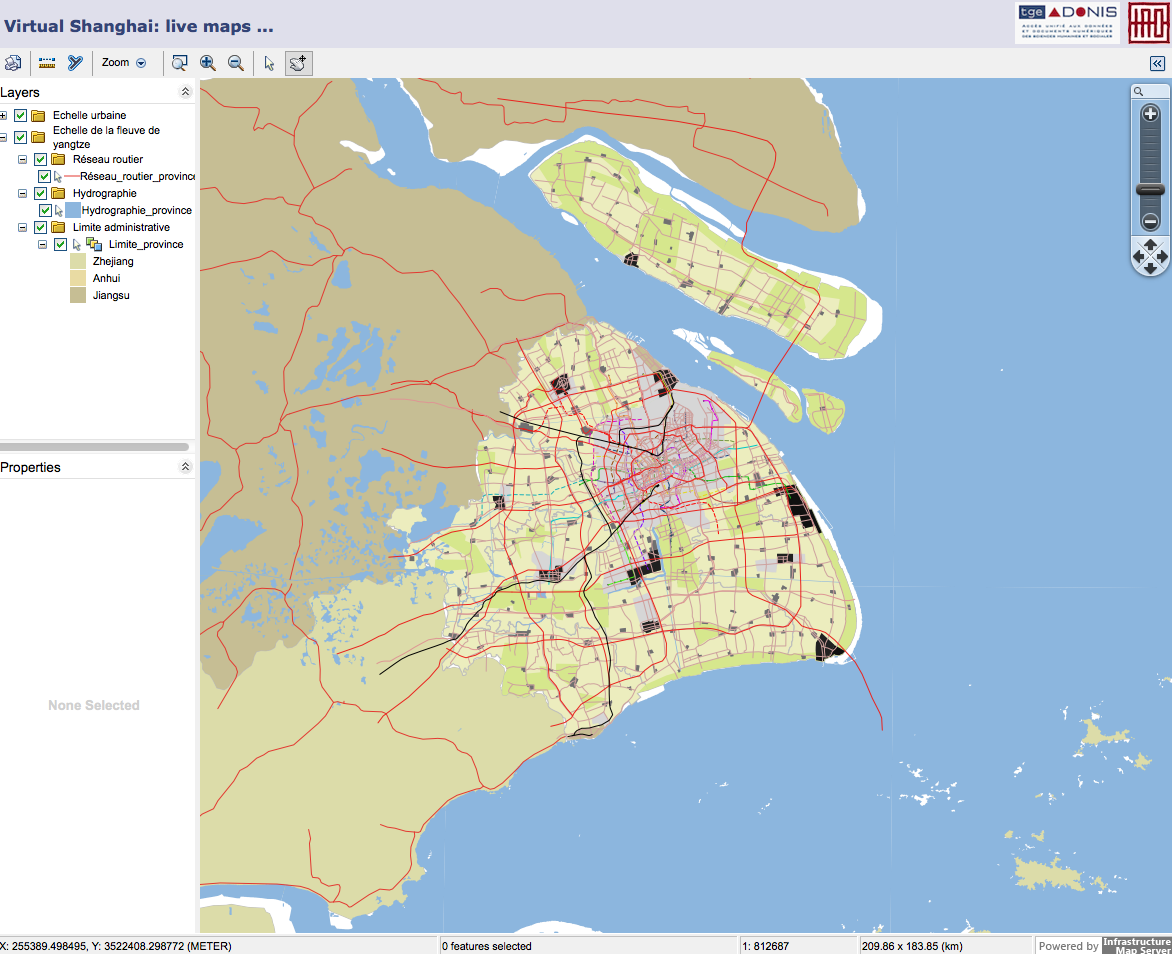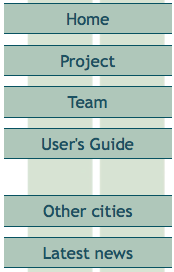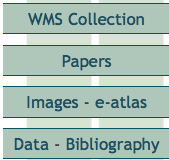User's Guide
Disclaimer: The Virtual Shanghai Project is a project... in progress. It does not stand for a complete and exhaustive history of Shanghai. Its content develops along with the research projects of its contributors. Its ultimate objective is indeed to provide a solid backgroud for an understanding of the historical trajectory of the city. Yet it should be read as an experiment in historical research in the digital age, with a view to go beyond the conventional ways of doing history and to propose alternative ways into the past of Shanghai.
The Virtual Shanghai platforms presents two sets of menus. The horizontal menu bar provides the main access to the data and documents. The vertical menu bar provides access to a presentation of the Vitual Shanghai project and to two thematic projects.
HORIZONTAL MENU BAR
The horizontal menu bar below displays entry links to the basic resources (maps, images, texts & data, references). There is a text of presentation for each maje type of resources. Just click in the green area on "Map collection", "Image & media", Texts & Data", and "References".

Map collection
[All maps]: click here to display all the maps in the map collection, whatever their nature. This will allow you to search the entire collection by title, year, keywords, etc.
Source maps: this menu serves to display the database of original historical maps collected in the course of the project in archives, libraries, books, etc. These are unadulterated original historical documents.
Base maps: this menu gives serves to display the "base maps" produced on the basis of historical documents. Mostly, thse base maps serve to define various administrative boundaries. They are made available in jpeg format, but they also exist as GIS shapefiles.
eAtlas: this menu gives serves to display the themetic maps produced by the Virtual Shanghai team. These maps are made available as jpeg images. Some of them are available as well as shapefiles and visible on Live maps.
Live Maps: this menu gives access to a page of presentation of the GIS (Geographical Information System) server and its two main "Live Maps": Shanghai Historical Maps and Shanghai XXIth Maps. On each platform, the user will find a collection of georeferenced historical and thematic maps in the form of layers. The user can select the layers to be displayed for analysis.


Images & media
Images: this menu serves to display the database of images (photographs, drawings, sketches, etc.) collected in the course of the project in archives, libraries, books, etc.
Albums: this menu will be phased out soon. Its finction will be integrated in the "Images" menu. Albums are built automatically on various topics based on core keywords in the metadata of images.
Visual narratives: this menu displays visual narratives produced with our own tool, VizStory. Visual narratives are image-driven narratives presented in the form of linear films, grids, and pearl trees. This menu is not yet activated. Opening soon !
Films: this menu serves to display the database of pre-1966 Chinese movies available for viewing or downloading.
Sountracks: this menu serves to display the database of sountracks (movie soundtracks, songs, etc.). This section is still under development due to various copyright restrictions.
Texts & Data
Papers: this menu serves to display the database of papers (conference papers, short papers, essays, etc.) produced by the members of the Virtual Shanghai team. The papers take full advantage of the potential for multiple linkages (hypertext) between the various elements on the platform (maps, images, bibliography, etc.).
E-Library: this menu serves to display the database of original textual documents collected in the course of the project in archives, libraries, books, etc. It does not aim at establishing a complete library of Shanghai-related works. The selection of documents reflects the needs of individual projects among the members of the research team.
Appendices: this menu serves to display miscellaneous documents produced or collected in the course of individual projects. They include reference materials (company list, glossary, etc.) considered to be useful for reasearch and difficult to come by.
Data: this menu serves to display quantitattive data files, mostly in the form of Excel spreasheets, on a wide range of subjects. They represent raw, but verified quantitative data collected from primary sources.
Analytics: this menu serves to display processed quantitative data in the form of static and animated visualizations. This section is not open yet. It is scheduled to open on 1st July 2016.
Buildings: this menu serves to display the database of pre-1949 buildings culled from various historical sources and from the two editions of Shanghai shi hanghao lutu lu (1939-1941 and 1947). Altogether, this represents amore than 2,000 locations. The number of recorded places is increasing with each new survey. We shall add soon thousands of factories as well as hundreds of entertainment facilities.
References
Bibliography: this menu serves to display the database of bibliographical references on the history of Shanghai in Chinese, English, Japanese, and various European languages. The database aims at a full coverage for books and academic papers (in academic journals) in English. Pleas feel free to contact the Virtual Shanghai Project (Mail: contact@virtualshanghai.net) to provide additional references.
Biography: this menu serves to display the database of biographies of individuals mentioned in different sections of the Virtual Shanghai platform, in particular the author of images and maps. The biography section provides only elementary biographical information to contextualize the images. For more complete information on historical events and on historical actors, see our Actoz database (coming soon !)
Publisher: this menu serves to display the database of publishers, with as much information as we have been able to gather. This is used to identify mostly the publishers of maps. All the maps produced by an identified publisher are linked to that publisher and displayed under its name. Just click on individual publishers in the displayed list.
Repository: this menu serves to display the database of repositories (libraries, archives, etc.) of images, mostly photographs. All the images found in a repository are linked to that repository and displayed under its name. Just click on individual repositories in the displayed list.
Note: The authentification fields in the dep green horizontal bar are relevant only for the direct contributors of the project. The general users have access to all the public materials withou any restriction and without authentification.
VERTICAL MENU BAR [right-hand side]
The vertical menu bar presents three sets of menus: General project, Special collections, and References. It also offers the possibility to change language.
Language selection: To change the language of the interface, click on the grey button just below the deep green horizontal bar. IMAGE OF SELECTOR. Users can choose between English, Traditional Chinese, and Simplified Chinese. For authentificated users, changing languge will also change the interface in all the internal fields of the database.


General Project
This set of buttons provides links to pages of presentation of the Virtual Shanghai Project and related projects.
Home: This bu tton automaticaly bring the user back to the main home page of the Virtual Shanghai Platform.
tton automaticaly bring the user back to the main home page of the Virtual Shanghai Platform.
Project: This button opens of page with a general presentation of the Virtual Shanghai Project.
Team: This button opens of page of presentation of all the current and past contributors to the Virtual Shanghai Project.
User's Guide: This button takes the user to the present User's Guide page.
Other Cities: This button opens a page of presentation of the global Virtual Cities project, an offspring of the generic platform developed for Virtual Shanghai. It also provides links to the platform of other individual virtual cities.
Latest news: This is the embedded micro-blog of Virtual Shanghai. It also provides links to the official Virtual Shanghai blog and to the War Made Shanghai blog.
Special Collections
WMS Collection [War Made Shanghai]
 The WMS project is an ANR (National research Agency) funded research project. In this collection we display the materials and the resources collected or produced in the course of research. All these materials and resources are located in the general collections of the Virtual Shanghai Project. In the WMS collection, a search engine harvests and collates these documents to build an identifiable collection and to highlight the achievements of the project.
The WMS project is an ANR (National research Agency) funded research project. In this collection we display the materials and the resources collected or produced in the course of research. All these materials and resources are located in the general collections of the Virtual Shanghai Project. In the WMS collection, a search engine harvests and collates these documents to build an identifiable collection and to highlight the achievements of the project.
Papers: this menu serves to display the papers (conference papers, short papers, essays, etc.) produced in the course of the WMS project.
Images: this menu serves to display the images (photographs, drawings, sketches, etc.) related to the WMS project.
eAtlas: this menu serves to display both original historical maps and themetic maps ) related to the WMS project.
Data: this menu serves to display the quantitattive data files, mostly in the form of Excel spreasheets, related to the WMS project.
Bibliography: this menu serves to display the bibliographical references related to the WMS project in Chinese, English, Japanese, and various European languages.
IPRAUS Collection
 This collection by IPRAUS is devoted to 21st century Shanghai. Ipraus is a research laboratory of the Paris-Belleville National school of Architecture. It is part of a larger CNRS-funded research center (UMR AUSser). The Ipraus team is currently involved in studies of the urban transformation of Shanghai since 2000.
This collection by IPRAUS is devoted to 21st century Shanghai. Ipraus is a research laboratory of the Paris-Belleville National school of Architecture. It is part of a larger CNRS-funded research center (UMR AUSser). The Ipraus team is currently involved in studies of the urban transformation of Shanghai since 2000.
Images: this menu serves to display the images (photographs, drawings, sketches, etc.) produced by Ipraus.
Maps: this menu serves to display the themetic maps produced by Ipraus.
References
Terms of use: This button points to a page with several tabs:
 - copyright issues: this page defines the conditions of use of the materials and resources of the Virtual Cities, including Virtual Shanghai, by the genral public.
- copyright issues: this page defines the conditions of use of the materials and resources of the Virtual Cities, including Virtual Shanghai, by the genral public.
- Information to donors: this page defines the conditions under which the irtual Shanghai Project hopes to receive documents from private donors.
Agreement temple: this is our standard agreement template, in English and in French, for potential donors.
Toolbox: this button open an external page with our wiki-based toolbox. Namely, the toolbox defines the common rules for the use of the Virtual Shanghai platform, especially on how to fill in the different fields of the various databases (images, maps, texts, etc.). It also provides elements of information and advice for research in the field, on the use of audio-visual equipment, etc. The toolbox is public, but only authentificated users can edit its pages.
Last update on Tuesday 26 April 2016 (21:49) by C. Henriot
Site created by Gérald Foliot with webActors - Hosted by TGIR Huma-num
The site is part of the Virtual Cities Project: Beijing - Hankou - Saigon - Shanghai - Suzhou - Tianjin - Wenzhou - Zhejiang
Select language : English | 简体字 | 繁體字
Page rendering in 0.004s



